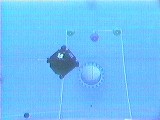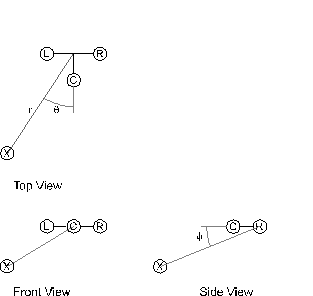 The University
of Maryland Space Systems Laboratory and the KISS
Institute for Practical Robotics (with cooperation from Newton Research Labs) have simulated
autonomous spacecraft docking in a neutral buoyancy tank for inclusion
on the UMD’s Ranger space vehicle. Using a composite target
of three brightly-colored objects designed by David
P. Miller, the spacecraft knows its distance and orientation,
and can servo to arbitrary positions around the target.
The University
of Maryland Space Systems Laboratory and the KISS
Institute for Practical Robotics (with cooperation from Newton Research Labs) have simulated
autonomous spacecraft docking in a neutral buoyancy tank for inclusion
on the UMD’s Ranger space vehicle. Using a composite target
of three brightly-colored objects designed by David
P. Miller, the spacecraft knows its distance and orientation,
and can servo to arbitrary positions around the target.
The following is adapted from:
David P. Miller and Anne Wright. Autonomous Spacecraft Docking Using Multi-Color Targets. In Proceedings of the 6th Topical Meeting on Robotics, Monterey, CA, February 1995.

The target is composed of three parts: "L", "C", and "R" (left, center, and right). "X" is the position of the camera. Note that q is measured in the plane of LRX, not LRC.


Relationships yielding the 3-dimensional position of the robot relative to the target, given the 2-dimensional positions (in camera space) of the three target elements as viewed from the robot. xl, yl, xc, yc, xr, yr are the positions, in camera space, of the left, center, and right targets, respectively, as viewed from the robot.
Back to the Cognachrome Vision System
home page
Back to the Newton Labs Academic/Research
home page